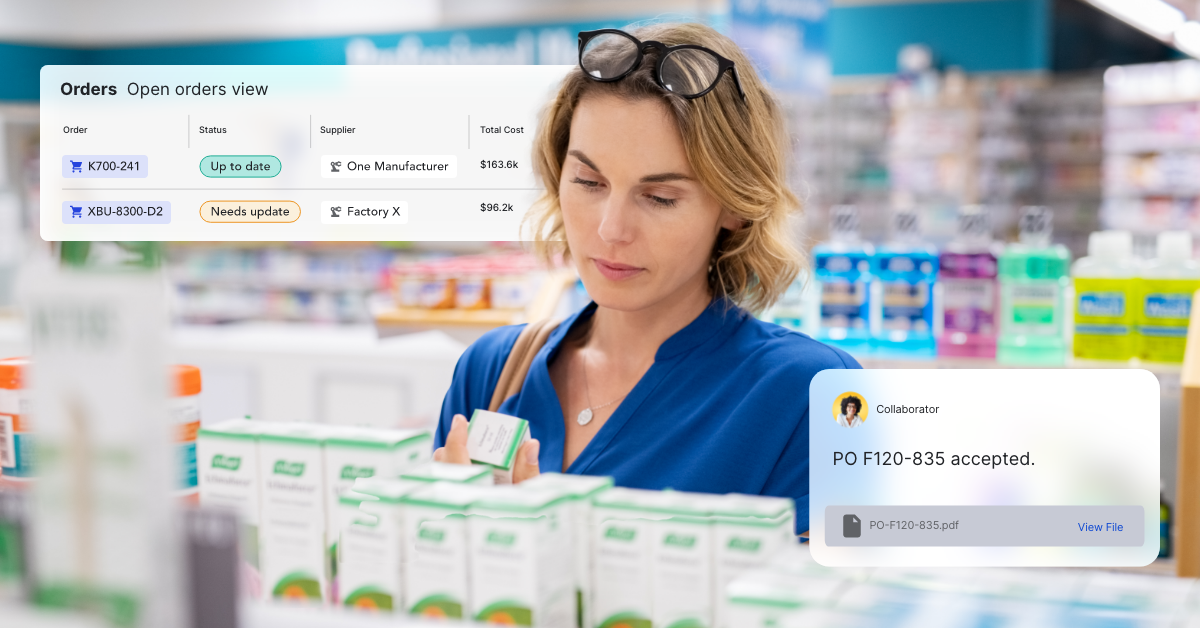Mastering purchase order management is crucial to maintaining an efficient supply chain.
But the more complex the supply chain, the more challenging it can be to manage purchase orders—especially for health and wellness brands selling across multiple channels and managing multiple suppliers in different parts of the world.
Despite these challenges, the health and wellness market continues to grow. McKinsey estimates that the global wellness industry is worth $1.8 trillion, with the wellness market in the US alone growing at 5 to 10 percent per year—now reaching a total worth of around $480 billion.
This rapid growth means health and wellness brands need to manage purchase orders efficiently and effectively to keep up with increasing demand, which is largely driven by millennial and Gen Z shoppers who purchase products across multiple channels.
So, how can health and wellness brands optimize their purchase order management processes to increase productivity and profitability and keep up with rising demand? Let’s dive in!
Top purchase order management challenges for health and wellness brands
Health and wellness brands face many of the same challenges as other consumer brands—from managing inventory and keeping items in stock to keeping transportation costs low.
Other top challenges include:
- Regulatory Compliance: Health and wellness brands must navigate a complex landscape of regulations that govern the production and distribution of their products. Ensuring compliance can be a significant challenge, especially when dealing with products that claim health benefits, as these are heavily scrutinized by regulatory bodies.
- Quality Control: Maintaining the highest quality standards is crucial for health and wellness brands, not only because consumers trust these products for their health benefits, but also because maintaining quality control is crucial for meeting regulations . Ensuring consistent quality and dealing with potential quality issues from suppliers can pose significant challenges.
- Demand Forecasting: Accurately predicting consumer demand is particularly challenging for health and wellness brands due to rapidly changing market trends and consumer preferences. Overestimating demand can lead to excess inventory, while underestimating can result in stockouts and lost sales.
- Supplier Reliability: Building and maintaining a reliable network of suppliers is critical. Health and wellness brands often rely on specialized ingredients that may be subject to availability issues, requiring strong supplier relationships to ensure steady supply.
- Product Innovation and Lifecycle Management: The health and wellness sector is highly competitive and rapidly evolving. Brands must continuously innovate and manage the lifecycle of their products efficiently to keep up with consumer expectations and market trends.
The good news is that with the right supply chain tools and technology, you can address these challenges and help your brand save time and money while moving purchase orders through your supply chain safely and efficiently.
Best practices for efficient purchase order management
1. Leverage technology for automation
Implementing an automated purchase order management system instead of relying on outdated spreadsheets can drastically reduce manual errors and save time.
Automation helps in tracking orders, updating inventory levels, and managing supplier communications, which enhances overall efficiency.
Supply chain visibility software can automate the creation of POs, pulling information directly from a centralized database. This ensures that product names, quantities, pricing, and other details are always accurate and consistent.
Supply chain visibility software also provides standardized templates that include all the necessary fields, such as product descriptions, unit prices, and shipping information.
These templates prevent omissions and inconsistencies, ensuring that each purchase order follows the same structured format.
You can also set up automated approval workflows using supply chain software.
For example, when a purchase order is created, it can be routed to the appropriate internal stakeholders for review and approval.
This ensures that every purchase is authorized by the right people before being sent to suppliers, preventing unauthorized or excess spending.
2. Audit supplier performance to strengthen relationships
Regular communication and collaboration with suppliers can help in negotiating better terms and ensuring more reliable supply chains. And establishing strong relationships makes it faster and easier to revolve issues as they arise, and provides more flexibility in managing your overall supply disruptions.
The best way to measure supplier performance is to track key performance indicators (KPIs), including on-time delivery, quality, customer feedback, and more.
You can also use a supplier scorecard to track supplier performance more systematically.
Beyond quality, you can also weigh other factors in your supplier evaluations, including pricing, product range, sustainability practices, and customer service.
Prioritizing suppliers based on on-time delivery and quality ultimately helps you manage costs, streamline your supply chain, and boost end-customer satisfaction.
3. Analyze purchase order data to identify trends
By scrutinizing historical purchase order data and sales trends, for example, you can easily discern patterns in product demand and forecast future needs.
This helps maintain optimal inventory levels and reduces the likelihood of stockouts and high costs associated with carrying inventory.
You can also leverage purchase order data to pinpoint slow-moving or obsolete inventory and make better-informed decisions about product discontinuation and inventory clearance.
Finally, you can use purchase order data to pinpoint potential risks and disruptions.
Compare key performance indicators (KPIs) such as purchase order cycle time, order accuracy, and supplier compliance alongside external factors like geopolitical events, weather conditions, and market shifts to proactively identify potential disruptions and develop better contingency plans.
4. Encourage cross-functional collaboration
Encouraging collaboration between different departments—such as purchasing, sales, finance, and logistics—can lead to a more cohesive purchase order process.
This collaboration ensures that all parts of the organization are aligned, which can improve decision-making and response times to market changes, like seasonal high and low demand.
Centralizing all of your first-mile supply chain data and communications into one system is one of the best ways to give your whole supply chain team, suppliers, and other stakeholders full visibility into purchase order status, making is easier for them to collaborate and stay up to date with changes as they happen in real-time.
Heading: Discover
5. Track purchase orders in real-time
Real-time visibility into purchase orders gives you a bird’s eye view of how every order progresses from creation to fulfillment.
Supply chain visibility software provides real-time tracking so you can quickly identify any issues or delays and take action to keep things moving.
For example, you can easily set up alerts and notifications to address supplier-related issues before they become problems that impact your customers.
Real-time tracking also provides valuable data on supplier performance, product demand, and inventory turnover that can be used to make data-driven decisions.
This information can be used to optimize purchasing strategies, negotiate better terms with suppliers, and allocate resources more effectively across your entire supply chain.
Ready to discover how you can better manage purchase orders with supply chain visibility software?
Start by booking a call with a supply chain expert to learn how Anvyl can help you gain more visibility, collaboration, automation, and intelligence in your supply chain.



